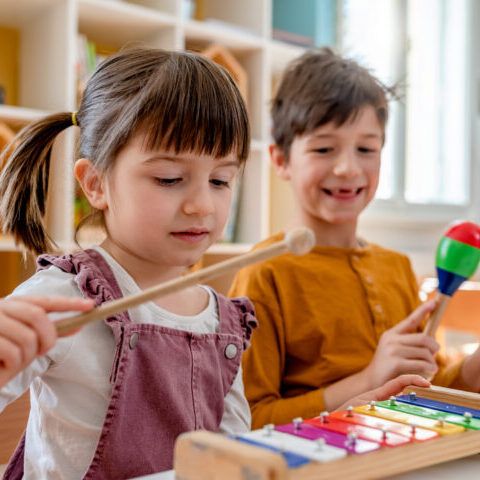Music adds to both fun and learning in the early childhood classroom. Children enjoy listening to music, making music, and moving to music. Music is a way to communicate, express emotion, and share the rich heritage to be found in our multicultural world.
Let children listen to music together and by themselves.
- Share a variety of music with the group as a whole. Then offer choices at a listening center.
- Invite children to talk about the ideas and feelings the music brings to mind. Have art materials available so children can draw or paint what they hear in the music.
- Offer all kinds of music. Choose old and new children’s songs, folk songs, and popular and classical music. Include music from a variety of cultures, languages, and time periods.
- Share background information so children can begin to know artists, styles, and instruments. “Here’s another song by Tish Hinojosa.”
Sing a variety of songs together.
- Share songs you enjoyed singing as a child. Write the title and lyrics on a large sheet of paper to help children connect the lyrics with written words.
- Read and sing from colorful children’s books, such as Going to the Zoo by Tom Paxton.
- Ask a librarian to suggest books or CDs of sing-along children’s songs to learn along with your class.
Provide simple instruments so preschoolers can create their own music.
- Find safe, child-friendly musical toys—such as xylophones, bells, drums, maracas, or small keyboards—at a toy store or yard sale.
- Avoid those that play a limited number of tunes with the push of a button or turn of a handle.
Make your own musical instruments.
- Turn almost any box or container into a drum.
- Make a shaker by placing small beads, buttons, or gravel inside a covered container and taping the lid on firmly.
- Try a rubber band banjo. Stretch several different rubber bands across an open shoe box. Vary the width and tension of the bands to produce different notes.
Move to the music and make exercise fun.
- Try marching songs or action songs, such as “Hokey-Pokey” or “Head, Shoulders, Knees, and Toes.”
- Encourage clapping hands or tapping feet to a strong rhythm.
- Provide props such as scarves or costumes and let children create their own dance movements.
- Bring music outside and have musical experiences on the playground. Encourage children to run when a song is fast and walk when it is slow, or put their hands up high when they hear high notes and low when they hear low notes.
IEL Resource
- Resource List: Music for Preschool Children


 PDF
PDF